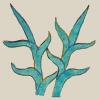acatl (Mdz13r)
This element has been carved from the compound glyph for the place name, Acatepec. It features two, fairly short, turquoise-colored plants (acatl) that, in the original compound glyph, were located on top of a hill or mountain (tepetl).
Stephanie Wood
The use of these plants underlines the reading of acatl. The other acatl sign that is also represented at top of the hill or mountain is a piece of an arrow, which will sometimes also have the phonetic value of acatl). Besides being a plant that was prevalent in the landscape, acatl was a year sign in the calendar.
Wikipedia has published a photo of acatl plants.
Stephanie Wood
c. 1541, but by 1553 at the latest
Stephanie Wood
arrows, reeds, rushes, plants, canes, darts, arrows, xiuhpohualli, año, turquesa, xihuitl

aca(tl), reed, cane, https://nahuatl.wired-humanities.org/content/acatl
tepe(tl), hill, mountain, https://nahuatl.wired-humanities.org/content/tepetl
reed, reeds
la caña
Stephanie Wood
Codex Mendoza, folio 13 recto, https://digital.bodleian.ox.ac.uk/objects/2fea788e-2aa2-4f08-b6d9-648c00..., image 36 of 188.
The Bodleian Libraries, University of Oxford, hold the original manuscript, the MS. Arch. Selden. A. 1. This image is published here under the UK Creative Commons, “Attribution-NonCommercial-ShareAlike 3.0 License” (CC-BY-NC-SA 3.0).




